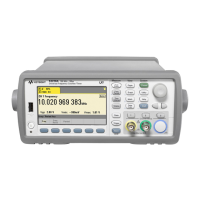Numeric Suffixes on Commands
Certain commands have numeric suffixes appended to the command name. For example:
INPut[{1|2}]:
RANGe {<range> | MINimum | MAXimum | DEFault}
These suffixes distinguish multiple instances of the same subsystem. Note that the numeric suffix is
optional; if it is omitted, "1" is assumed. In this example, INPut1 or INPut refers to channel 1; INPut2 refers
to channel 2.
Command Separators
A colon ( : ) is used to separate a command keyword from a lower-level keyword. You must insert a blank
space to separate a parameter from a command keyword. If a command requires more than one para-
meter, you must separate adjacent parameters using a comma as shown below:
CONF:FREQ 10.0E6,0.003
A semicolon ( ; ) is used to separate commands within the same subsystem, and can also minimize typing.
For example, sending the following command string:
TRIG:SOUR EXT; COUN 10
... is the same as sending the following two commands:
TRIG:SOUR EXT
TRIG:COUN 10
Use a colon and a semicolon to link commands from different subsystems. For example, in the following
command string, an error is generated if you do not use both the colon and semicolon:
TRIG:COUN MIN;:SAMP:COUN MIN
Using the MINimum, MAXimum, and DEFault Parameters
For most commands, you can substitute "MINimum", "MAXimum" or "DEFault" in place of a parameter.
For example, consider the following command:
SAMPle:COUNt {<count> | MINimum | MAXimum | DEFault}
Instead of selecting a specific value for the <count> parameter, you can substitute MIN to set the count to
its minimum value, MAX to set the count to its maximum value, or DEF to set the count to its default value.
Querying Parameter Settings
You can query the current value of most parameters by adding a questionmark (?) to the command. For
example, the following command sets the trigger count to 10 measurements:
TRIG:COUN 10
Keysight 53220A/53230A Programmer's Reference 13
Introduction to the SCPI Language

